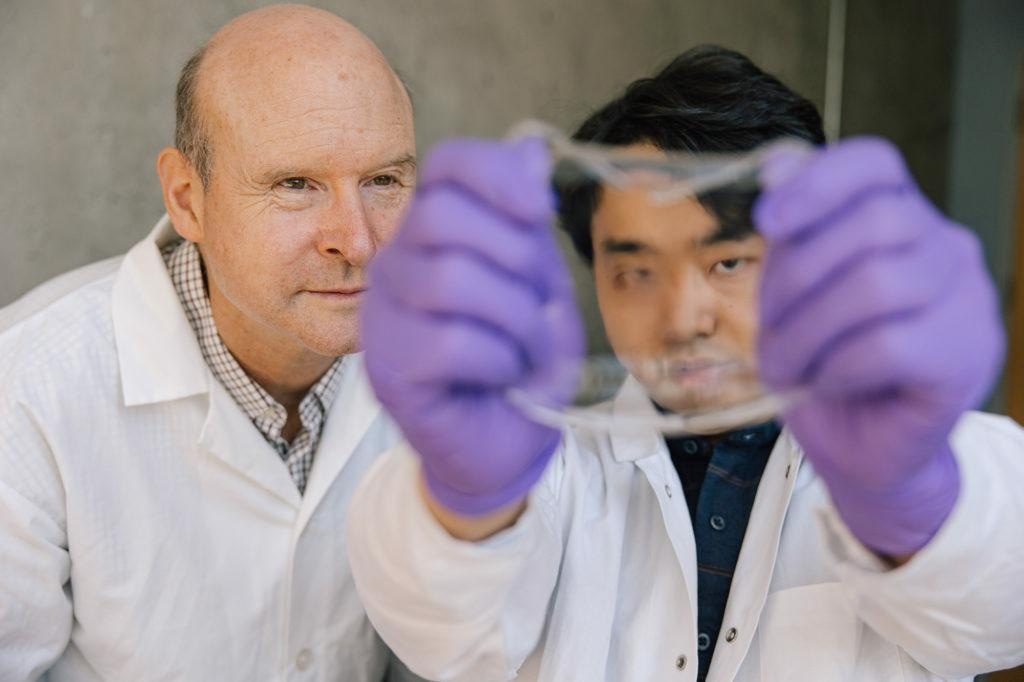Ionic skins have shown considerable advantages in creating smart skin that matches the sensing capabilities of real skin. Composed of flexible and biocompatible hydrogels, they transmit an electrical charge via ions.
 Dr. John Madden and Yuta Dobashi with one of the hydrogel sensors. Image Credit: Kai Jacobson/UBC Faculty of Applied Science.
Dr. John Madden and Yuta Dobashi with one of the hydrogel sensors. Image Credit: Kai Jacobson/UBC Faculty of Applied Science.
Unlike smart skins made of plastics and metals, hydrogels have the suppleness of natural skin. This gives the prosthetic arm or robot hand they are attached to a more natural feel, making it more comfortable to use.
Voltages are generated when the hydrogels come into contact. However, scientists were unable to figure out the reason behind it, until a team of researchers from UBC designed a distinctive experiment and published the study in Science.
How hydrogel sensors work is they produce voltages and currents in reaction to stimuli, such as pressure or touch—what we are calling a piezoionic effect. But we didn’t know exactly how these voltages are produced.
Yuta Dobashi, Study Lead Author, University of British Columbia
Dobashi, working under the guidance of UBC researcher Dr. John Madden, developed hydrogel sensors comprising salts with positive and negative ions of various sizes. Magnetic fields were used by him and researchers from the physics and chemistry departments of the UBC to measure how the ions traveled when pressure was applied to the sensor.
Dobashi says, “When pressure is applied to the gel, that pressure spreads out the ions in the liquid at different speeds, creating an electrical signal. Positive ions, which tend to be smaller, move faster than larger, negative ions. This results in an uneven ion distribution which creates an electric field, which is what makes a piezoionic sensor work.”
The researchers say that the new information proves that the hydrogels perceive pressure much like humans, which is by shifting ions in response to pressure, thereby opening up new uses for ionic skins.
The obvious application is creating sensors that interact directly with cells and the nervous system, since the voltages, currents and response times are like those across cell membranes. When we connect our sensor to a nerve, it produces a signal in the nerve. The nerve, in turn, activates muscle contraction.
Dr. John Madden, Professor, Electrical and Computer Engineering, Faculty of Applied Science, University of British Columbia
Dr. Madden further states, “You can imagine a prosthetic arm covered in an ionic skin. The skin senses an object through touch or pressure, conveys that information through the nerves to the brain, and the brain then activates the motors required to lift or hold the object. With further development of the sensor skin and interfaces with nerves, this bionic interface is conceivable.”
A soft hydrogel sensor placed on the skin monitoring the vital signs of a patient while being completely inconspicuous and producing its own power is another application.
Dobashi, who is now doing his Ph.D. at the University of Toronto, is eager to continue working on ionic technologies once he completes his studies.
Dr. Madden adds, “We can imagine a future where jelly-like ‘iontronics’ are used for body implants. Artificial joints can be implanted, without fear of rejection inside the human body. Ionic devices can be used as part of artificial knee cartilage, adding a smart sensing element. A piezoionic gel implant might release drugs based on how much pressure it senses, for example.”
According to Dr. Madden, the market for smart skins was worth $4.5 billion in 2019, and it is still growing.
Dr. Madden concludes, “Smart skins can be integrated into clothing or placed directly on the skin, and ionic skins are one of the technologies that can further that growth.”
Yael Petel, a UBC chemistry Ph.D. graduate and Carl Michal, a UBC professor of physics, contributed to the study published in Science. They employed the interplay between intense magnetic fields and the nuclear spins of ions to track ion movements inside the hydrogels. Cédric Plesse, Giao Nguyen, and Frédéric Vidal of CY Cergy Paris University in France contributed to the development of a new hypothesis on how hydrogels produce charge and voltage.
Journal Reference:
Dobashi, Y., et al. Piezoionic mechanoreceptors: Force-induced current generation in hydrogels. Science. doi.org/10.1126/science.aaw1974.